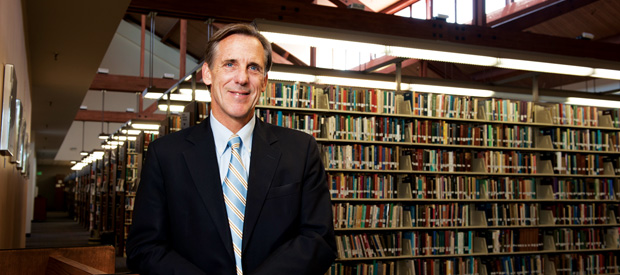Why We Need Libraries in the Digital Age
Pepperdine Magazine is the feature magazine for Pepperdine University and its growing community of alumni, students, faculty, staff, and friends.
Cyberspace is a tool, it is not a place.

By Mark Roosa, Dean of Libraries
In this era of Google, Twitter, Facebook, and Wikipedia, some might ask: why do we
need libraries? Can’t students get everything they need online? Won’t students become
wiser simply by spending more quality time online with their laptops or iPhones?
The Internet has become deeply embedded into every aspect of our private and public
lives. In the academy as well, the Internet and the growing cyber-infrastructure that
carries information to us and facilitates scholarly work has become an essential fixture
in the lives of students.
Without question, the cyber-toolbox has created wonderful new pathways to information.
Take, for example, the pure power that online databases provide for quickly locating
facts about virtually any person, place, or thing, or the possibilities that cyber-technology
holds for bringing together massive geospatial information, which would otherwise
be largely inaccessible.
Technology has enabled us to build wonderfully rich digital collections across the
country that support teaching, learning, and research, but I would argue that technology
in and of itself does not necessarily guarantee that students will become smarter.
There is mounting evidence that too much random screen time may in fact hinder deep
thinking, contemplation, analysis, and reading and writing skills—things so essential
to success in the world beyond the campus.
Consider T. S. Eliot’s prophetic warning from the 1930s:
Where is the life that we have lost in living?
Where is the wisdom we have lost in knowledge?
Where is the knowledge we have lost in information?
-The Rock
The Library as Place... "A Home for the Heart"
As our students have become more and more cyber-dependent, an interesting thing is
happening on our college campuses: library use is on the rise.
It turns out that students come to our libraries for the type of fulfillment cyberspace
can’t offer. They come to see their friends, to work in groups, to think, and to find
a quiet space far from the distractions of everyday campus life. Increasingly, the
Payson Library on our Malibu campus offers just this sort of haven. It is, in many
ways, already the biggest classroom and the biggest living room on campus, a new student
union where students reflect, exchange ideas with one another, and grow intellectually.
The library offers quiet space for contemplation in a comfortable setting. In short,
our library is a home for the heart, soul, and mind. A destination:
...where students are exposed to new ideas and where thoughtful inquiry is encouraged.
Each year we host a broad array of faculty and guest lectures on topics ranging from
the human genome project to global warming to Mozart to the African American experience.
...where students become discerning information users and consumers and learn to expand
their horizons beyond Google. In addition to providing information literacy instruction
to roughly 4,000 students a year, our new search and retrieval portal called WorldCat
Local provides users with access to more than 100 million titles from libraries around
the world.
...where students find hospitality and flexible seating. And it is open late.
The combination of these elements is a winner; and as we have emphasized them, student
use of our libraries has steadily increased. On a busy night one is hard pressed to
find a seat in Payson Library. Circulation of materials and use of online resources
are also off the charts. It is an exciting time.
What We've Accomplished and What Lies Ahead
We are encouraged by the progress that we have made to create intelligent and welcoming
libraries at Pepperdine, places that build community and encourage learning.
We have upgraded our print collections and evaluated our electronic holdings to better
align them with our academic programs. As we have made these improvements, happily,
we have seen increased use of the collections.
Today’s libraries are not just aggregators of information; they are distributors and
publishers as well. Pepperdine on iTunes U, a free online broadcast service that features
audio and video presentations by faculty, guest lecturers and members of our community,
now garners over 4,000 weekly downloads.
We will continue to explore new ways to serve our students by providing knowledge
resources and new spaces that encourage use of those resources. Preparing students
to be lifelong learners (and users of libraries) is both a library vocation and a
civic responsibility.
Conclusion
We are gratified by the substantial progress made to date to build a 21st-century
library for our students. Just as Pepperdine is on the rise in so many areas, I believe
that we are on the rise with our libraries. Our students deserve it and our legacy
demands it.
With continued support from our community and donors, we look forward to building
a great library for our great University, a ‘home for the heart, soul, and mind’,
that will, in the words of our founder George Pepperdine, “help young men and women
to prepare themselves for a life of usefulness in this competitive world and help
them build a foundation of Christian character and faith which will survive the storms
of life.”
ONLINE DIGITAL COLLECTIONS FROM PEPPERDINE LIBRARIES
The new Digital Collections feature digitized versions of special collections and
archival materials, including the Pepperdine yearbook Collection, a complete and searchable
collection of Pepperdine yearbooks from 1939 to 2006; the John Mazza Historic Surfboard
Collection; and the ever-growing University Archives Photograph Collection, presenting
high-resolution digital renditions of the thousands of photographic prints, slides,
and negatives that compose the Pepperdine University archival image collection, dating
from its founding in 1937.
Explore these collections and more: library.pepperdine.edu
